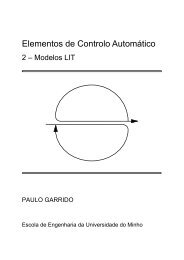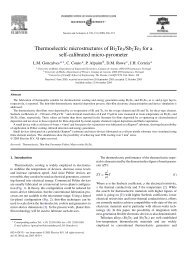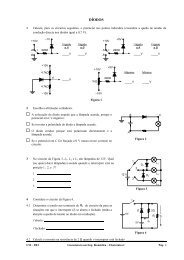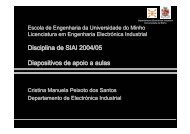Fluorodeoxyglucose - Wikipedia, the free encyclopedia
Fluorodeoxyglucose - Wikipedia, the free encyclopedia
Fluorodeoxyglucose - Wikipedia, the free encyclopedia
You also want an ePaper? Increase the reach of your titles
YUMPU automatically turns print PDFs into web optimized ePapers that Google loves.
<strong>Fluorodeoxyglucose</strong> - <strong>Wikipedia</strong>, <strong>the</strong> <strong>free</strong> <strong>encyclopedia</strong><br />
<strong>Fluorodeoxyglucose</strong><br />
From <strong>Wikipedia</strong>, <strong>the</strong> <strong>free</strong> <strong>encyclopedia</strong><br />
(Redirected from FDG)<br />
<strong>Fluorodeoxyglucose</strong> is a glucose analog.<br />
Its full chemical name is 2-fluoro-2-deoxy-<br />
D-glucose, commonly abbreviated to FDG.<br />
<strong>Fluorodeoxyglucose</strong><br />
FDG is most commonly used in <strong>the</strong> medical<br />
imaging modality positron emission<br />
tomography (PET): <strong>the</strong> fluorine in <strong>the</strong> FDG<br />
molecule is chosen to be <strong>the</strong> positronemitting<br />
radioactive isotope fluorine-18, to<br />
produce 18 F-FDG. After FDG is injected into<br />
a patient, a PET scanner can form images of<br />
<strong>the</strong> distribution of FDG around <strong>the</strong> body. The<br />
images can be assessed by a nuclear<br />
medicine physician or radiologist to provide<br />
diagnoses of various medical conditions.<br />
Chemical name 2-Deoxy-2-fluoro-D-glucose<br />
2-Fluoro-2-deoxy-D-glucose<br />
O<strong>the</strong>r names<br />
FDG<br />
Chemical formula C 6 H 11 FO 5<br />
Molecular mass 182.15 g/mol<br />
CAS number<br />
[29702-43-0]<br />
[63503-12-8] ( 18 F)<br />
Density ? g/cm 3<br />
Melting point 170-176 °C<br />
http://en.wikipedia.org/wiki/FDG (1 of 5)20-04-2007 10:14:18
<strong>Fluorodeoxyglucose</strong> - <strong>Wikipedia</strong>, <strong>the</strong> <strong>free</strong> <strong>encyclopedia</strong><br />
●<br />
fate<br />
Contents<br />
1 Mechanism of action and metabolic<br />
SMILES<br />
O[C@H](C(CO)O[C@H](O)<br />
[C@H]1F)[C@H]1O<br />
Disclaimer and references<br />
●<br />
2 Applications<br />
●<br />
3 History<br />
●<br />
4 Means of production and distribution<br />
●<br />
5 References<br />
●<br />
6 External links<br />
Mechanism of action and metabolic fate<br />
FDG, as a glucose analog, is taken up by high-glucose-using cells such as brain, kidney,<br />
and cancer cells, where phosphorylation prevents <strong>the</strong> glucose from being released intact.<br />
The 2-oxygen in glucose is needed for fur<strong>the</strong>r glycolysis, so that (in common with 2-deoxy-<br />
D-glucose) FDG cannot be fur<strong>the</strong>r metabolized in cells, and <strong>the</strong>refore <strong>the</strong> FDG-6-<br />
phosphate formed does not undergo glycolysis before radioactive decay. As a result, <strong>the</strong><br />
distribution of 18 F-FDG is a good reflection of <strong>the</strong> distribution of glucose uptake and<br />
phosphorylation by cells in <strong>the</strong> body.<br />
Before FDG decays, it is inhibited from metabolic degradation or use, because of <strong>the</strong><br />
fluorine at <strong>the</strong> 2' position in <strong>the</strong> molecule. However, after FDG decays radioactively, its<br />
fluorine is converted to 18 O, and after picking up a H + from <strong>the</strong> environment, it becomes<br />
glucose-6-phosphate labeled with harmless nonradioactive "heavy oxygen" (oxygen-18) at<br />
<strong>the</strong> 2' position, and is <strong>the</strong>reafter metabolized normally in <strong>the</strong> same way as ordinary glucose.<br />
Applications<br />
http://en.wikipedia.org/wiki/FDG (2 of 5)20-04-2007 10:14:18
<strong>Fluorodeoxyglucose</strong> - <strong>Wikipedia</strong>, <strong>the</strong> <strong>free</strong> <strong>encyclopedia</strong><br />
In PET imaging, 18 F-FDG can be used for <strong>the</strong> assessment of glucose metabolism in <strong>the</strong><br />
heart and <strong>the</strong> brain. It is also used for imaging tumours in oncology. 18 F-FDG is taken up<br />
by cells, phosphorylated by hexokinase (whose mitochondrial form is greatly elevated in<br />
rapidly-growing malignant tumours) [1] , and retained by tissues with high metabolic activity,<br />
such as most types of malignant tumours. As a result FDG-PET can be used for diagnosis,<br />
staging, and monitoring treatment of cancers, particularly in Hodgkin's disease, non-<br />
Hodgkin's lymphoma, and lung cancer. It has also been approved for use in diagnosing<br />
Alzheimer's disease. Bro.<br />
In body-scanning applications in searching for tumor or metastatic disease, a dose of FDG<br />
in solution (typically 5 to 10 millicuries or 200 to 400 MBq) is typically injected rapidly into a<br />
saline drip running into a vein, in a patient who has been fasting for at least 6 hours, and<br />
who has a suitably low blood sugar. (This is a problem for some diabetics; usually PET<br />
scanning centers will not administer <strong>the</strong> isotope to patients with blood glucose levels over<br />
about 180 mg/dL = 10 mmol/L, and such patients must be re-scheduled). The patient must<br />
<strong>the</strong>n wait about an hour for <strong>the</strong> sugar to distribute and be taken up into organs which use<br />
glucose—a time during which physical activity must be kept to a minimum, in order to<br />
minimize uptake of <strong>the</strong> radioactive sugar in muscles (this causes unwanted artifacts when<br />
<strong>the</strong> organs of interest are inside <strong>the</strong> body). Then, <strong>the</strong> patient is placed in <strong>the</strong> PET scanner<br />
for a series of one or more scans which may take from 20 minutes to as long as an hour<br />
(often, only about quarter of <strong>the</strong> body length may be imaged at a time).<br />
History<br />
In <strong>the</strong> 1970s, Tatsuo Ido at <strong>the</strong> Brookhaven National Laboratory was <strong>the</strong> first to describe<br />
<strong>the</strong> syn<strong>the</strong>sis of 18 F-FDG. The compound was first administered to two normal human<br />
volunteers by Abass Alavi in August, 1976 at <strong>the</strong> University of Pennsylvania. Brain images<br />
obtained with an ordinary (non-PET) nuclear scanner demonstrated <strong>the</strong> concentration of<br />
FDG in that organ (see history reference below).<br />
http://en.wikipedia.org/wiki/FDG (3 of 5)20-04-2007 10:14:18
<strong>Fluorodeoxyglucose</strong> - <strong>Wikipedia</strong>, <strong>the</strong> <strong>free</strong> <strong>encyclopedia</strong><br />
Means of production and distribution<br />
Because <strong>the</strong> high energy particle bombardment conditions in <strong>the</strong> medical cyclotron which is<br />
used to produce 18 F would destroy organic molecules like deoxyglucose or glucose, <strong>the</strong><br />
radioactive 18 F must be made first as fluoride in <strong>the</strong> cyclotron. This may be accomplished<br />
by bombardment of neon-20 with deuterons, but usually is done by proton bombardment of<br />
18 O-enriched water, causing a (p,n) reaction (neutron knockout, or spallation) in <strong>the</strong> 18 O to<br />
produce 18 F as labeled hydrofluoric acid, HF. The quickly-decaying 18 F - (18-fluoride) is<br />
<strong>the</strong>n collected and immediately attached to <strong>the</strong> deoxyglucose in an automated series of<br />
chemical reactions in a "hot room" (radioisotope chemistry preparation chamber). Following<br />
this, <strong>the</strong> labeled FDG compound (with half-life only 109.8 minutes set by <strong>the</strong> decay of <strong>the</strong><br />
18 F) is rapidly shipped to points of use by <strong>the</strong> fastest possible mode. This may include<br />
dedicated small commercial jet services, to extend <strong>the</strong> reach of PET scanning to centers<br />
hundreds of miles away from <strong>the</strong> cyclotron which produces <strong>the</strong> radioisotope-labeled<br />
compound.<br />
References<br />
●<br />
GE Health page on FDG.<br />
●<br />
The Conception of FDG-PET Imaging. Abass Alavi and Martin Reivich.<br />
1. ^ High Aerobic Glycolysis of Rat Hepatoma Cells in Culture: Role of<br />
Mitochondrial Hexokinase -- Bustamante and Pedersen 74 (9): 3735 --<br />
Proceedings of <strong>the</strong> National Academy of Sciences. Retrieved on 2005 December<br />
5.<br />
External links<br />
●<br />
Links to external chemical sources<br />
http://en.wikipedia.org/wiki/FDG (4 of 5)20-04-2007 10:14:18
<strong>Fluorodeoxyglucose</strong> - <strong>Wikipedia</strong>, <strong>the</strong> <strong>free</strong> <strong>encyclopedia</strong><br />
Categories: Organofluorides | Monosaccharides | Radiopharmaceuticals | Neuroimaging<br />
This page was last modified 19:07, 6 April 2007. All text is available under <strong>the</strong> terms of <strong>the</strong> GNU Free<br />
Documentation License. (See Copyrights for details.)<br />
<strong>Wikipedia</strong>® is a registered trademark of <strong>the</strong> Wikimedia Foundation, Inc., a US-registered 501(c)(3) taxdeductible<br />
nonprofit charity.<br />
http://en.wikipedia.org/wiki/FDG (5 of 5)20-04-2007 10:14:18








